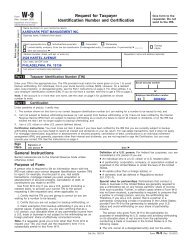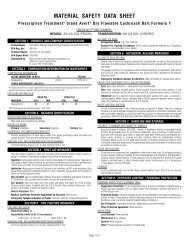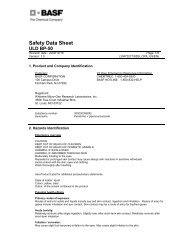Case Making Moth - Aardvarkpestmgmt.com - Aardvark Pest ...
Case Making Moth - Aardvarkpestmgmt.com - Aardvark Pest ...
Case Making Moth - Aardvarkpestmgmt.com - Aardvark Pest ...
- No tags were found...
Create successful ePaper yourself
Turn your PDF publications into a flip-book with our unique Google optimized e-Paper software.
Protecting Items in StorageClothes moths often damage articles that are not stored properly. Whenstoring susceptible items, be sure they are pest-free and clean, andplace them in an airtight container. Insect repellents can be placed in thestorage container. A new product made from lavender oil is available asa gel-filled sachet that can be used inside drawers and storage boxes, orhung in closets. Research studies are currently underway regarding theefficacy of this product.<strong>Moth</strong> balls, flakes, or crystals containing naphthalene or paradichlorobenzene are also available forprotecting clothes in storage. These materials are toxic and must be kept away from children and pets.They also leave an unpleasant odor on clothes and other cloth objects. If placed in contact with plasticbuttons, hangers, or garment bags, they may cause the plastic to soften and melt into the fabric. As thesechemicals evaporate, they produce vapors that, in sufficient concentration, will slowly kill insects. Thevapors build up to the required concentration only in an airtight container. If the container is not airtight,the chemicals only weakly repel adults and any larvae already on clothes continue to feed.Questions are often raised as to the effectiveness of cedar chests and closet floors made of cedar.Aromatic eastern red cedar, Juniperus virginiana, contains oil that is able to kill small larvae, but it doesnot affect large larvae. After several years, however, cedar loses this quality. Having the chest tightlyconstructed is more important in the long run than the type of wood used to make it.Freezing and HeatingClothes moths can also be controlled by heating the infested object for at least 30 minutes attemperatures over 120°F, freezing the object for several days at temperatures below 18°F, or fumigatingwith dry ice (see "Household Furnishings").TrappingTrapping is a relatively easy-to-use technique that helps to both detect a webbing clothes moth infestationand to reduce it. Pheromone traps are available to trap the webbing clothes moth, but not the casemakingclothes moth. Pheromones are chemicals (in this case a sex attractant) produced by an organism toaffect the behavior of other members of the same species. The sex pheromone attracts male moths intothe trap where they get stuck on the sticky sides. Because the pheromone specifically attracts clothesmoths, other moth species will not be attracted—conversely, webbing clothes moths will not be attractedto pheromone traps for other species such as grain-infesting moths. Pheromone traps for clothes mothsare available from major hardware stores.Place traps in closets and other areas where clothes are stored. Trapping not onlyallows you to detect the presence of webbing clothes moths but also providessome control because trapped males cannot mate. However, if you trap moths,you should also take other measures such as dry cleaning or laundering to protectclothes that were exposed to the moths.Using Insecticide SpraysIf clothes moths are detected, articles that cannot be dry cleaned, laundered, heated to temperatures over120°F, frozen, kept in cold storage, or fumigated with dry ice (see "Household Furnishings") can besprayed with an insecticide. Find a product that lists clothes moths on its label and follow the directionsexactly. Insecticides for clothes moths usually contain pyrethrins, which provide quick knockdown ofclothes moths, and most can be sprayed directly on fabrics if needed (in situations where fabrics cannotbe laundered or dry cleaned). Pyrethrin insecticides do not leave persistent toxic residues, which makesthem more suitable for clothes moth control in many cases than many other products.Some insecticides have an oil base. Do not spray them on silk, rayon, or other fabrics that stain easily. Donot use them around open flames, sparks, or electrical circuits. Do not spray them on asphalt-tile floors.







